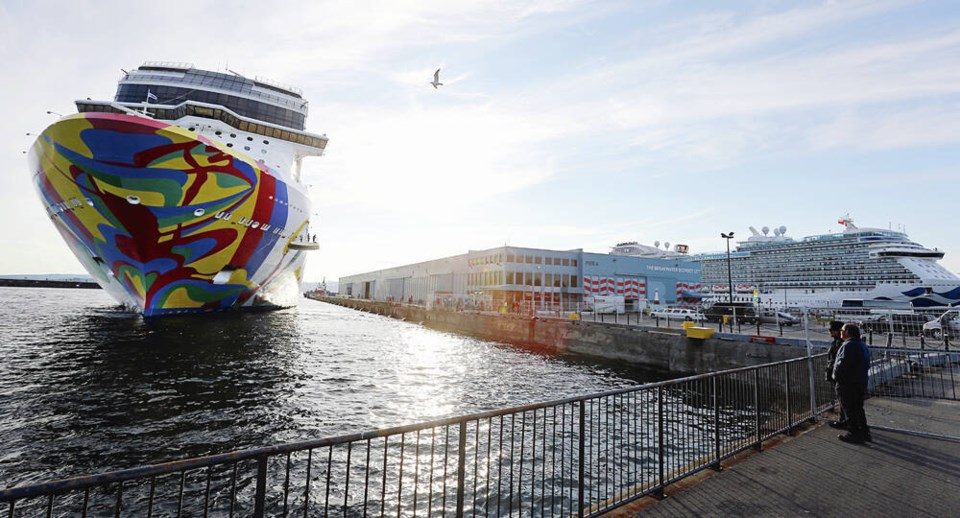A new regulation requiring ships to slow down to reduce their carbon emissions means cruise-ship passengers are spending less time and less money in downtown Victoria.
Many of the Alaskan cruises are coming in the late afternoon and leaving in the evening, Robert Lewis-Manning, CEO of the Greater Victoria Harbour Authority, said Wednesday.
Some even come in after 8 p.m., he said. “We’ve certainly had a few like that. It is having an impact.”
For the past four years, cruise ships have also been taking part in a voluntary slowdown at Swiftsure Bank to protect endangered southern resident killer whales.
All ships bound for Victoria, Seattle, Vancouver or Nanaimo must pass through the slowdown area, along both the outbound and inbound shipping lanes, a distance of 23 nautical miles.
While the slowdowns mean short-term pain for downtown businesses, it’s good for the endangered southern resident killer whales and in the long run, it’s good for the environment, said Lewis-Manning.
“Those are the trade-offs we will always be dealing with, but the longer-term plan, I think, is quite positive.”
Jeff Bray, chief executive officer of the Downtown Victoria Business Association, said the cruise-ship slowdowns mean thousands of passengers are disembarking after stores have closed.
If a cruise ship arrives at 8 p.m., passengers won’t be disembarking until 8:45 p.m and they have to be back on the boat by 11:30 p.m., said Bray.
“The real impact is that most businesses, outside of the hospitality industry, are closed. It also means excursions are really limited. If people are here for eight or nine hours, they can go downtown, visit the museum, Craigdarroch Castle. They can go whale-watching,” said Bray.
“If you’re in for three hours at night, you can go downtown and have an ice cream, maybe a beer. You’ve got thousands of people in port, but you’re not really able to service them.”
About 320 cruise-ship dockings with about 850,000 passengers are expected for Victoria this summer. The latest study by the harbour authority shows the cruise-ship industry injects about $130 million annually into the local economy, said Bray.
This year, the voluntary ship slowdown began June 1 and is in effect until Oct. 31.
Both Canada and the U.S. have identified underwater noise generated from ships as one of the key threats to killer whales due to its interference with their ability to hunt, navigate and communicate via echolocation. Swiftsure Bank is a known foraging area for southern residents.
Cruise ships, vehicle carriers and container vessels are asked to reduce their speed from about 20 to 22 knots down to 14.5 knots or less in the area. Bulk carriers, tankers and government vessels have been asked to reduce their speed to 11 knots or less.
“The biggest noise source is usually the propeller and at a certain speed, it actually generates or forms little air bubbles that explode and that’s the biggest source of noise,” said Lewis-Manning, who has a background in shipping.
“So if you can get the ships to be below their cavitation speed, which is usually between 15 and 20 knots, we can reduce the acoustic noise. Every knot of speed makes a significant difference. The more you slow down, the more you get exponentially less impact.”
The Swiftsure Bank program has been recognized globally, he said.
Meanwhile, under a new global regulatory regime that came into effect on Jan. 1, all ships will be evaluated annually on their ability to reduce their carbon intensity, Lewis-Manning said.
“It’s really designed in the early years to look at operational efficiencies, so that it includes things like reducing speed, changing your propeller to find more efficiencies, cleaning your hull — anything that will positively impact the carbon intensity of the vessel over its voyage.”
Every vessel, from a ship carrying grain from Canada to China to a cruise ship, is covered by the same regime, he said.
“It’s so early that I think a lot of shipping companies are trying to figure out what the long-term impact will be and how they will have to account for the change in their technical capabilities and their costs.”
The cruise-ship industry is also in a “slightly unpredictable period” because they’re trying to figure out how to plan and operate their itineraries under the new regime, Lewis-Manning said.
“This year, it has had some impact on the arrival times and duration of the stay. But cruise-ship companies know that Victoria is a fantastic destination and they want to prolong the experience of their passengers in Victoria. We’re working and talking to the cruise lines about how to do that in future.”
The harbour authority plans to install infrastructure at Ogden Point that would allow cruise ships to plug in to shore power, so they don’t need to use diesel generators.
“That will actually be a benefit under the regulatory regime and could be an incentive to stay longer,” said Lewis-Manning.
“If we can make the formula around their carbon intensity more positive by plugging in while they are in Victoria, that’s a double benefit.”
Lewis-Manning hopes the shore-power project will be completed in three or four years.
“Then the cruise lines will know that they can come here, plug in and that will reduce their carbon emissions as they head off to Alaska.”
No one can argue with cutting emissions or protecting endangered killer whales, said Bray.
“The Downtown Victoria Business Association would love to see ships in longer and ships in town during the day. But we know there are many pieces of the puzzle that all have to fit together in order for that to happen.”
>>> To comment on this article, write a letter to the editor: [email protected]



